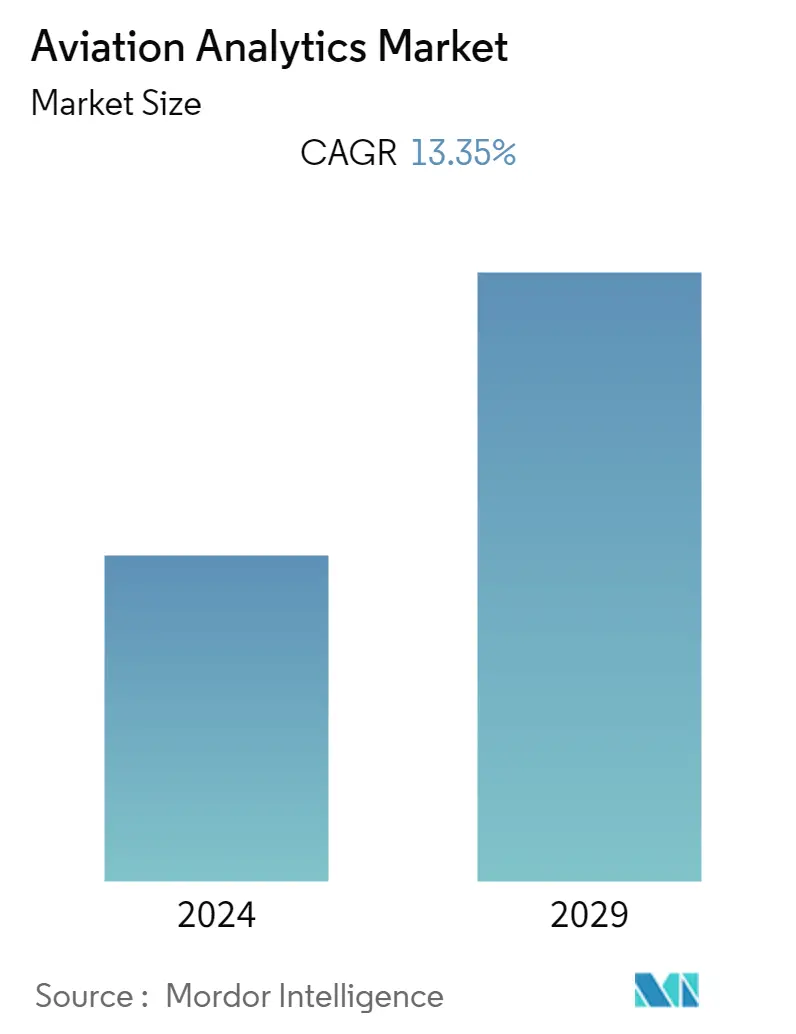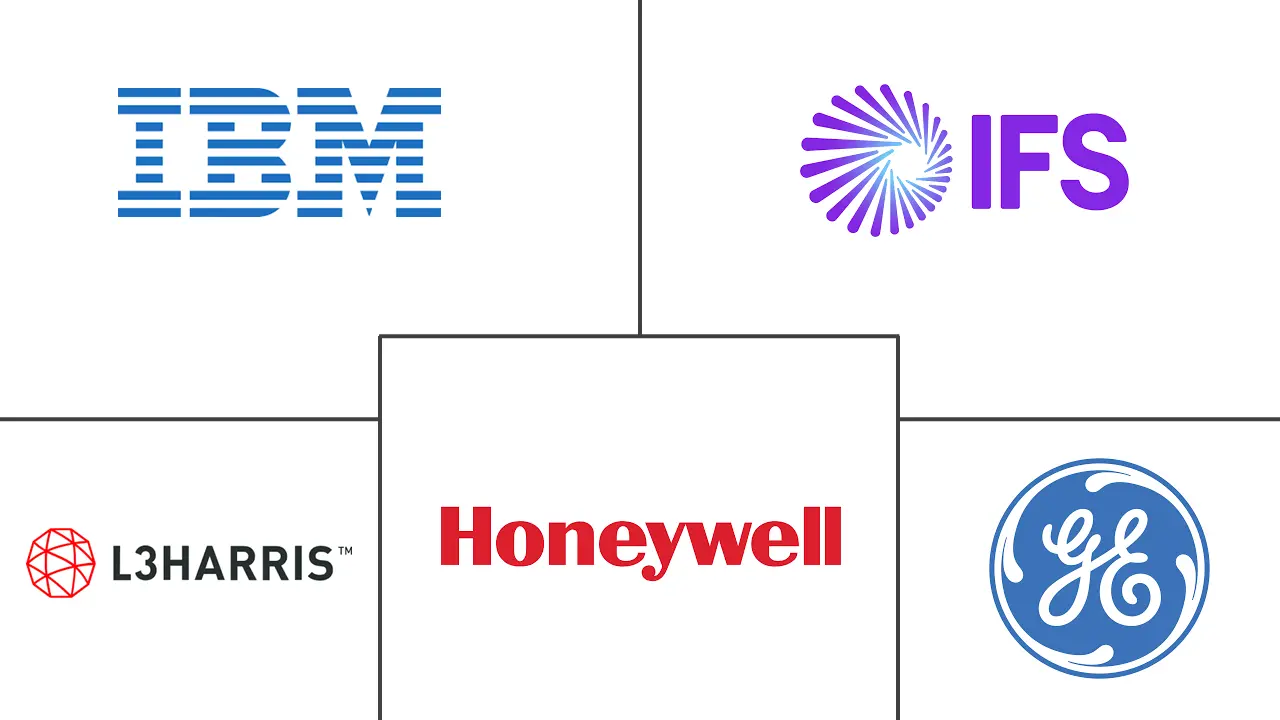Market Size of Aviation Analytics Industry

| Study Period | 2019 - 2029 |
| Base Year For Estimation | 2023 |
| CAGR | 13.35 % |
| Fastest Growing Market | Asia Pacific |
| Largest Market | North America |
| Market Concentration | Medium |
Major Players
*Disclaimer: Major Players sorted in no particular order |
Aviation Analytics Market Analysis
The Aviation Analytics Market is valued at USD 3.22 billion in 2023 and is expected to grow to USD 6.02 billion by 2028, registering a CAGR of 13.35% during the forecast period (2023-2028).
Data analytics plays a critical role in the airline industry as it provides valuable benefits such as improved efficiency, enhanced customer experience, increased security, and reduced costs. The increasing demand for optimized business operations is one of the major factors driving the market for aviation analytics. The market growth is also attributed to the rising adoption of advanced analytics solutions across business functions in the aviation industry. Airlines are widely adopting analytics for various aspects of airline operation management. For instance, airlines use analytics with built-in machine learning algorithms to collect and analyze flight data regarding each route's distance and altitude, aircraft type and weight, weather, etc. Based on the findings, systems estimate the optimal amount of fuel needed for a flight. Additionally, an increase in focus on digitalizing airport operations and reducing human interference is also creating opportunities for the aviation analytics market. However, a lack of expertise in integrating conventional devices with modern technology will restrain the growth of the market in the forecast years.
Aviation Analytics Industry Segmentation
Aviation analytics is the ability to measure performance and risk across all aspects of the flight business that is used by airlines and airports to improve operations.
End-user, business function, application, and geography segment the aviation analytics market report. By end user, the market is segmented into airlines and airports. By business function, the market is segmented into sales & marketing, finance, MRO operations, and supply chain. By application, the market is segmented into risk management, inventory management, fuel management, revenue management, customer analytics, and others. The market sizing and forecasts for all the segments are provided in value (USD).
| End User | |
| Airlines | |
| Airports |
| Business Function | |
| Sales & Marketing | |
| Finance | |
| MRO Opertions | |
| Supply Chain |
| Application | |
| Risk Management | |
| Inventory Management | |
| Fuel Management | |
| Revenue Management | |
| Customer Analytics | |
| Others |
| Geography | |||||||
| |||||||
| |||||||
| |||||||
| |||||||
|
Aviation Analytics Market Size Summary
The aviation analytics market is experiencing significant growth, driven by the increasing demand for optimized business operations within the airline industry. Data analytics is becoming indispensable, offering benefits such as enhanced efficiency, improved customer experiences, heightened security, and cost reduction. The adoption of advanced analytics solutions is on the rise, with airlines leveraging machine learning algorithms to analyze various operational data, including flight routes, weather conditions, and aircraft specifications. This analytical capability is crucial for optimizing fuel management and other operational aspects. Additionally, the push towards digitalizing airport operations and minimizing human intervention is creating further opportunities for market expansion. However, challenges such as the integration of traditional devices with modern technology may hinder growth in the coming years.
The market is witnessing a surge in fleet expansion and modernization efforts by airlines globally, which in turn fuels the demand for aviation analytics. Notable examples include Ethiopian Airlines and Wizz Air, which are significantly increasing their fleet sizes. This expansion necessitates advanced analytics for effective fleet, fuel, and revenue management. Partnerships, such as that between American Airlines and Microsoft, highlight the industry's commitment to leveraging technology for better operational and customer experiences. The Asia-Pacific region is expected to lead in growth, driven by increased air traffic and fleet expansion, as seen in countries like India and China. The market is consolidated, with major players like IBM, Honeywell, and GE Digital dominating, and competition is intense as these companies vie for long-term contracts and market share through various strategic initiatives.
Aviation Analytics Market Market Size - Table of Contents
-
1. MARKET DYNAMICS
-
1.1 Market Overview
-
1.2 Market Drivers
-
1.3 Market Restraints
-
1.4 Porter's Five Forces Analysis
-
1.4.1 Bargaining Power of Suppliers
-
1.4.2 Bargaining Power of Buyers/Consumers
-
1.4.3 Threat of New Entrants
-
1.4.4 Threat of Substitute Products
-
1.4.5 Intensity of Competitive Rivalry
-
-
-
2. MARKET SEGMENTATION
-
2.1 End User
-
2.1.1 Airlines
-
2.1.2 Airports
-
-
2.2 Business Function
-
2.2.1 Sales & Marketing
-
2.2.2 Finance
-
2.2.3 MRO Opertions
-
2.2.4 Supply Chain
-
-
2.3 Application
-
2.3.1 Risk Management
-
2.3.2 Inventory Management
-
2.3.3 Fuel Management
-
2.3.4 Revenue Management
-
2.3.5 Customer Analytics
-
2.3.6 Others
-
-
2.4 Geography
-
2.4.1 North America
-
2.4.1.1 United States
-
2.4.1.2 Canada
-
-
2.4.2 Europe
-
2.4.2.1 United Kingdom
-
2.4.2.2 Germany
-
2.4.2.3 France
-
2.4.2.4 Rest of Europe
-
-
2.4.3 Asia-Pacific
-
2.4.3.1 China
-
2.4.3.2 India
-
2.4.3.3 Japan
-
2.4.3.4 South Korea
-
2.4.3.5 Rest of Asia-Pacific
-
-
2.4.4 Latin America
-
2.4.4.1 Brazil
-
2.4.4.2 Rest of Latin America
-
-
2.4.5 Middle East and Africa
-
2.4.5.1 Saudi Arabia
-
2.4.5.2 United Arab Emirates
-
2.4.5.3 South Africa
-
2.4.5.4 Rest of Middle East and Africa
-
-
-
Aviation Analytics Market Market Size FAQs
What is the current Aviation Analytics Market size?
The Aviation Analytics Market is projected to register a CAGR of 13.35% during the forecast period (2024-2029)
Who are the key players in Aviation Analytics Market ?
IBM Corporation, IFS, L3Harris Technologies, Inc., Honeywell International Inc. and GE Digital (General Electric Company) are the major companies operating in the Aviation Analytics Market .

